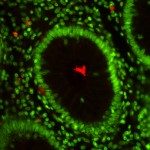Link to Pubmed [PMID] – 8741212
Eur. J. Cell Biol. 1996 Apr;69(4):308-15
In the organ of Corti, outer hair cells (OHCs) are sensory effectors responsible for the high sensitivity and sharp tuning of the cochlea. Whilst the distribution and organization of actin and tubulin in adult OHCs have been extensively studied, less is known about developing OHCs. In this study we use a quantitative cytometric approach on rat isolated OHCs to measure the distribution of these cytoskeletal proteins from the first stages of development (postnatal day 5) to the adult stage. We report a general decrease in both actin and tubulin concentrations during OHC maturation. Actin first decreases in the apical domain, and then in the medio-basal domain. In the apical domain, this could be related to the physiological reduction in the number of stereocilia occurring during ciliogenesis. In the medio-basal domain, the decrease, accompanied by a redistribution of actin toward the lateral wall, is possibly related to the general reorganization of cytoplasmic organelles, to the maturation of the cortical lattice, and to cell growth. Tubulin concentration decreases regularly in both the apical and the medio-basal domains. This developmental change in tubulin concentration could be due to the regression of the kinocilium that occurs by the end of ciliogenesis, and, as argued for actin, to the general reorganization of cytoplasmic organelles, and to cell growth.


